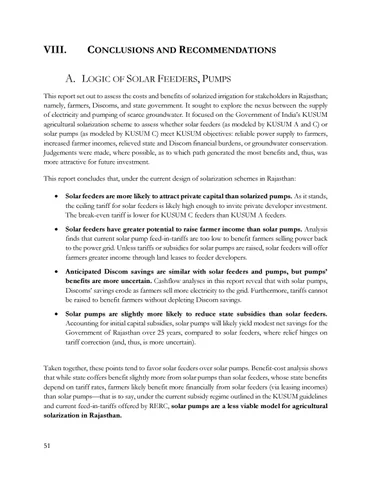VIII.
CONCLUSIONS AND RECOMMENDATIONS LOGIC OF SOLAR FEEDERS, PUMPS
This report set out to assess the costs and benefits of solarized irrigation for stakeholders in Rajasthan; namely, farmers, Discoms, and state government. It sought to explore the nexus between the supply of electricity and pumping of scarce groundwater. It focused on the Government of India’s KUSUM agricultural solarization scheme to assess whether solar feeders (as modeled by KUSUM A and C) or solar pumps (as modeled by KUSUM C) meet KUSUM objectives: reliable power supply to farmers, increased farmer incomes, relieved state and Discom financial burdens, or groundwater conservation. Judgements were made, where possible, as to which path generated the most benefits and, thus, was more attractive for future investment. This report concludes that, under the current design of solarization schemes in Rajasthan: •
Solar feeders are more likely to attract private capital than solarized pumps. As it stands, the ceiling tariff for solar feeders is likely high enough to invite private developer investment. The break-even tariff is lower for KUSUM C feeders than KUSUM A feeders.
•
Solar feeders have greater potential to raise farmer income than solar pumps. Analysis finds that current solar pump feed-in-tariffs are too low to benefit farmers selling power back to the power grid. Unless tariffs or subsidies for solar pumps are raised, solar feeders will offer farmers greater income through land leases to feeder developers.
•
Anticipated Discom savings are similar with solar feeders and pumps, but pumps’ benefits are more uncertain. Cashflow analyses in this report reveal that with solar pumps, Discoms’ savings erode as farmers sell more electricity to the grid. Furthermore, tariffs cannot be raised to benefit farmers without depleting Discom savings.
•
Solar pumps are slightly more likely to reduce state subsidies than solar feeders. Accounting for initial capital subsidies, solar pumps will likely yield modest net savings for the Government of Rajasthan over 25 years, compared to solar feeders, where relief hinges on tariff correction (and, thus, is more uncertain).
Taken together, these points tend to favor solar feeders over solar pumps. Benefit-cost analysis shows that while state coffers benefit slightly more from solar pumps than solar feeders, whose state benefits depend on tariff rates, farmers likely benefit more financially from solar feeders (via leasing incomes) than solar pumps—that is to say, under the current subsidy regime outlined in the KUSUM guidelines and current feed-in-tariffs offered by RERC, solar pumps are a less viable model for agricultural solarization in Rajasthan.
51






